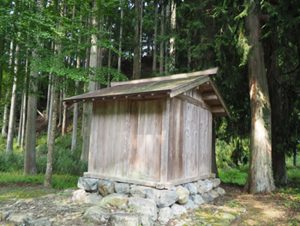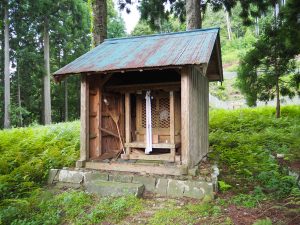Series “Visiting Villages” 36 A Trip to the Ado River Basin with the Author of “Shrines at Rest: The Changing Future of Sacred Places” ④
The diverse shrines scattered throughout Japan convey the profound regional diversity of Japan. Even small, unknown shrines carry the deep history and significant meaning of their communities. (Kei Kitajima)

志故淵神社(Shikobuchi Shrine)
After leaving Aya Shrine, we headed to Kutsuki-no-Isugi in Takashima City. The Kutsuki area was formerly Kutsuki Village, which became Takashima City in 2005 through a municipal merger. Kutsuki-no-Isugi is the most remote settlement in Shiga Prefecture, located upstream of the Harihata River, the source of the Azumi River. Further inland lies the border between Shiga, Kyoto, and Fukui Prefectures. We headed to Okawa Shrine, quietly nestled within its confines. It’s about an hour’s drive from Aya Shrine, downstream of the Azumi River, to Okawa Shrine, upstream of the Harihata River.
Departing from Yokoehama in Azumigawa Town and passing through the city, we enter the Kuchiki area, surrounded by forest. The Kuchiki area is home to many shrines bearing the name “Shikobuchi.”
According to Professor Shimada, “Along the Azumigawa River, there are 15 shrines named ‘Shikobuchi,’ two shrine ruins, and two ko (groups of people with a shared faith). The kanji characters used for the names include Omoshibuchi and Shikobuchi.”
The Kuchiki area was originally ruled by the Kuchiki clan. Since modern times, the Kuchiki clan has served as chief priests for the shrines in the Kuchiki area, a position they continue to hold to this day.
“This is also a Shikobuchi Shrine,” Shimada pointed out the window as he drove.
What came into view was a building that looked almost like a farm tool shed. It had no torii gate and didn’t look like a shrine at all. Its modest design makes it easy to pass by without being told it was a shrine.
Professor Shimada explains, “This is just speculation,” but adds, “This shrine enshrines the god of raft drifting. It’s likely that lumber and other materials were stored here. It’s possible that the shrine was built here because it was a place where technicians and merchants who reassembled rafts gathered.”
The shrine, located at a bend in the Kitagawa River, is known by locals as “Udodani Ebetsu no Shikobuchi Shrine.” Along with the Harihata River, the Kitagawa River forms the source of the Azumi River. It is unusual to read Ieichi as “Ebetsu,” and some say it may be an Ainu place name.

大川神社(Okawa Shrine)
After driving a short distance from there, a small settlement came into view. This is the Kutsuki Noritake settlement. There are idyllic houses lined up, but no one lives there. Most of the village’s residents have moved to Takashima City, and apparently only come here on weekends to farm.
“In recent years, there has been an increase in villages with houses but no one living there,” says Professor Shimada.
After another 20 minutes of driving, we entered Kutsuki Isugi.
We got out of the car and walked through the grass, where we discovered a small shrine with a blue roof. It was Okawa Shrine. It’s a tiny shrine nestled deep in the densely wooded mountains. It doesn’t appear on standard maps or in the Shiga Prefecture Shrine Guide, so it’s a shrine known only to those in the know.
“See that stream flowing here?” Shimada pointed out, and sure enough, there was water flowing. The flow was so gentle that you wouldn’t know it was a river if you weren’t told.
“This is the Okawa River. The locals affectionately call it Okawa,” Shimada explained.
In the past, the flow was much greater, and timber cut down in the mountains was floated one by one toward the Azumi River. Because it was a key location for timber transport, shrines dedicated to the mountain gods and tree gods were built, and it came to be called Okawa Shrine.
However, now that timber is transported by truck, there’s no trace of its former prosperity as a key river transport hub.
“In a sense, it’s a shrine that has outlived its role.” I said, to which Professor Shimada replied, “No, it still has a role. It is cherished by the local people as a shrine to keep wild boars away.” “To keep wild boars away?” I asked again, to which Professor Shimada replied, “Wild boars come down from the mountains, so it became a shrine to keep them away. I guess the role of the gods also changes with the times.”
Even so, there is a great variety of shrines, and they tell us today that Japan once consisted of countless diverse regions. From world-famous, magnificent shrines like Ise Grand Shrine and Izumo Taisha Shrine to humble, quiet shrines like Aya Shrine, Shikobuchi Shrine, and Okawa Shrine. While these are certainly small, unknown shrines, they carry the deep history and important meaning of their region.
Professor Shimada says he is considering measures to allow more people to experience the charm of these small shrines.
Various ingenuity is needed to create tourism that satisfies visitors. Because it is an unknown shrine, without a proper explanation, people will not understand the significance of its existence and will just pass it by without paying it any attention.
“What I’m thinking about now is cleaning tourism, where tourists tour the shrine while cleaning up together with local people. It’s a win-win experience as tourists get to know local people and learn about the background of the shrine, and the local people are able to clean up their area,” says Shimada.
※Translating Japanese articles into English with AI
